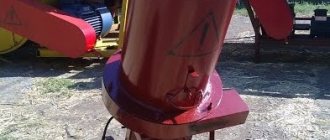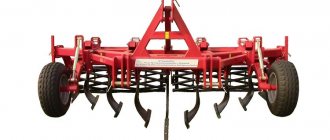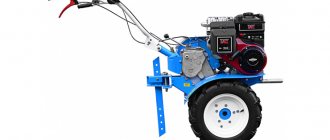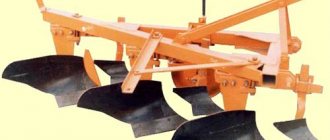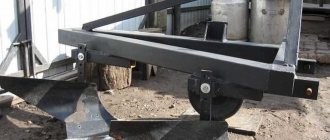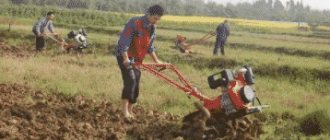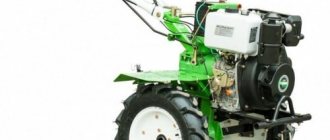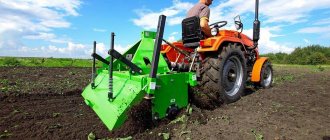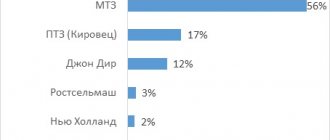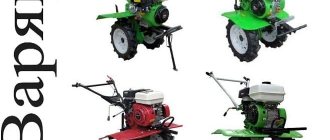Every agricultural worker knows what a plow is. For those who are far from this sphere, it should be recalled that a plow is a tool for plowing the soil.
Initially, these devices were carried by people, and only over time this heavy burden was transferred to oxen, horses and mules. Now the plow is attached to a regular tractor or walk-behind tractor.
The main task of this tool is to turn over the top layer of earth . This plowing helps reduce the number of weeds in the area and also makes the soil softer and more pliable. With the help of such a rotation of the earth, weed seeds that have not yet sprouted find themselves deep underground.
This tool is presented in the form of a wide plowshare. Often the ploughshare is made of metal. A plow can also be called a device for laying cables or for working under water.
Varieties
The following types of such units can be distinguished:
- Rotary;
- Chisel;
- Ploughshares;
- Disk;
- Combined.
The most common are plowshare plows. This type was used by our ancestors, but even now they can also be found in the fields in working condition. Disc plows are used to plow heavy soil or dry soil. The combined and rotational type is used on complex devices that are used for cultivating virgin soil. The chisel type of tool does not provide for formation turnover. This type is classified as a plow conditionally and is very rarely used in agriculture.
According to the type of traction, the entire tool can be divided into the following categories:
- Tractor. This is the most convenient and common type. Such tools are produced for different models, so they are perfect for both a regular tractor and a mini-tractor or walk-behind tractor;
- For horse traction. This type is now very rare. Often they are used to cultivate those areas of land where a tractor cannot pass;
- On a cable car. This variety is used only in places where neither a tractor nor a horse can pass. Often this is a marshy area or a large slope.
Plows are available for both general and special purposes. Special purpose tools are divided into the following subgroups:
- For processing rocky soils. Such instruments have a special protective mechanism that protects the instrument from large stones;
- Negotiable. Their main feature is the presence of two identical plows, which are placed in a mirror image. Thanks to this technology, it is possible to perform smooth plowing, that is, to create a flat surface, without large embankments and furrows;
- Longline. Used to increase soil fertility.
Plow - pages of history
Agriculture is one of the most ancient types of human activity. It originated when man moved from simple gathering to productive labor.
For a long time, millennia BC, this labor was hoeing. The hoe worked well in loose soil in Mesopotamia and in the floodplain of the Nile River. However, in the process of settling people and developing new lands, people needed to cultivate new lands - virgin soil with perennial grasses, with a large number of roots. Here it was necessary not only to plow, but also to cut the turf.
The ancient people considered the plow a gift from the Gods. The Egyptians attributed it to the creations of Osiris, the Greeks - Pallas Athens, the Indians - Agni, and the inhabitants of China - the divine Shenpung. In its original form, the plow descended from the so-called “furrow stick” - a stick, a forked stick with a sharp part that makes a furrow. It was with her help that they first began to loosen the earth by dragging, instead of the usual digging. However, this tool, which was the prototype of the plow, could not cope with dense turf. To get through the turf, it was necessary to increase the pressure on the part of the tool going into the ground. This is how the first plow with a handle appeared.
The first plow consisted of three quite recognizable elements - a drawbar, by which it was pulled across the field, a ploughshare that went into the ground, and a handle. One person pulled the plow behind him and the other walked behind him using a handle, deepening the plow into the ground and guiding it.
It is assumed that the next stage in the development of the plow occurred in the 6th millennium BC. in Mesopotamia. This was due to the domestication of oxen. It was these animals that were the first to be adapted to work with the plow. Originally, the plow's drawbar was simply tied to their horns. Later the yoke and the first harness appeared. Of course, the emergence of draft power significantly increased the rate of land cultivation and made the work of peasants easier.
We owe the next most important milestone in the history of the development of the plow to the ancient Romans. In the works of Pliny. A Roman writer of the 1st century AD described a plow that was already equipped with a wheel for adjusting the depth of travel, a knife in front of the ploughshare, cutting the soil and, most importantly, the first blade, which no longer simply discarded, but turned over a layer of turf. This improvement led to the fact that after processing, the fertile layer that plants needed so much was on the surface, and the weeds were underground with the prospect of becoming a new nutrient layer. The first dumps were made of wood in the form of an oblong quadrangle.
The plow remained this way until the Middle Ages. In the 15th-17th centuries in Europe there was an active development of cities, crafts, and, as a result, blacksmith and foundry crafts. At that time, Belgium and Holland were especially successful in these areas. It is not surprising that it was then, around the middle of the 17th century, that the first plows with an all-metal curved moldboard appeared almost simultaneously in these countries. They became the Brabant (Flanders) plow and the Rotterdam plow. The Brabant plow was similar to the Roman one in the use of a support limber, which made it possible to control the depth into the soil. A horizontal cross bar with holes, attached to the front end, regulated the width of the plowing area. For it, the blade and the ploughshare were made separately and combined into a structure.
The Rotterdam plow did not have a limber in its design due to the peculiarities of Dutch soils, but it was the first to use an all-metal moldboard ploughshare that did not clog at the joint. At that time it was a huge step forward. This plow was developed by Joseph Foljambe in 1730. It was strong, lightweight, and created according to mathematical calculations by Scottish designer James Small.
The key moment in the history of the plow came during the Industrial Revolution and is associated with a name that is now known to every person familiar with agriculture. This man was the American blacksmith John Deere. It was he who, in 1837 in Grand Detour, Illinois, in an effort to help farmers with the cultivation of heavy prairie soil, because the usual cast-iron plows at that time simply could not cope with it, created the first well-polished steel plow blade from a broken hacksaw blade. In early 1838, Deere completed his first steel plow and sold it to local farmer Lewis Crandall, who quickly spread word of his success with Deere's plow. A year after his first success, blacksmith John Deere became an industrialist. He later recalled that he created 10 plows in 1839, 75 in 1841 and 100 in 1842. By 1855, Deere's factory had sold more than 10,000 plows.
From the very beginning, Deere insisted on producing high quality equipment. He once said: “I will never put my name on a product that does not contain the best that is in me.”
The first steel plows were operated by a person, but very quickly the design was changed so that the person was already sitting on a special seat on wheels, and the plow itself already had several shares.
With the advent of steam engines, unique huge plows used in America entered history. One such plow was pulled by up to ten steam engines, which made it possible to plow huge areas of land in a day.
This interesting phenomenon became history with the advent of gasoline engines, whose power was simply not enough for such a large weapon.
An interesting version of the plow, called the Stump Jump, was invented in the 1870s in Australia for plowing vineyard lands. Its device allowed the plow share to jump over obstacles in the form of roots on its own, which made it possible to avoid breakage and continue plowing. A simpler system developed later uses a concave disk (or two) set at a high angle to the direction of travel. The concave surface keeps the disc in the ground unless something solid gets underneath it, and when the plow hits a tree root or rock, the plowshare bounces.
Modern plows, which can now be easily seen on farms, are divided according to the type of plowing:
- furrow traditional plows that turn the earth in only one direction, indicated by the blade of the ploughshare. They work “dumping” (with the formation of a double ridge, when the unit starts moving from the middle of the paddock and moves along an expanding spiral) or “waddle” (with the formation of a double furrow, when the unit starts moving at the edge of the paddock and moves along a narrowing spiral);
— reversible plows allowing for “smooth plowing.” These plows have double “mirror” reversible shares. One set of works, the second looks to the sky. Having reached the edge of the field, the plowshares change places, which makes it possible to obtain a plowed surface with ridges in one direction.
Special-purpose plows stand apart from traditional ones. Among them:
- disc plows used in the development of new territories for plowing heavy, weedy lands, swamp soils or lands after clearing up a forest zone. The working bodies of this type of plow are spherical disks mounted on the plow frame, rotating on axles;
— forestry plows specially adapted for planting and sowing forest crops;
— tiered plows for two- and three-level plowing of solonetzic and podzolic soils;
— planting plows designed for deep plowing for vineyards and fruit plantations.
Although it has changed significantly, today, like centuries ago, the plow remains a faithful assistant to any farmer.
Author: Monastyreva Galina
see also
Protected soil, greenhouses
A little about growing lettuce in greenhouse conditions 10/31/2017
Industry events
Twice Anniversary of good ascetic labor in our native land 10/31/2017
Plow selection
Many owners of summer cottages have repeatedly thought about the fact that they can cultivate the soil themselves. If you still decide to implement this idea, then you will need a walk-behind tractor and a special plowing element for it . When choosing a unit, pay attention to the power of the walk-behind tractor and the amount of land that can be processed with its help. The power of the mini-tractor can be found in the data sheet, which should come with the unit. Please note that the plow should be selected for a specific walk-behind tractor model, otherwise the tool may turn out to be very heavy and it will be impossible to perform the work.
When choosing the size of the unit, you should focus primarily on the amount of land that you need to plow. For waterlogged soil, it is best to use a disc machine. This type is more resistant to heavy loads, therefore, it will last longer. The plowshare type of plow is best used on soil that has already been cultivated.
Recommendations
To ensure that the device serves you as long as possible , try to follow all recommendations for its operation. Before starting the unit, you should make sure that there are no people or animals in the area. To avoid damaging the instrument, it is recommended to clear the area of large stones, metal objects and beams in advance. This will minimize the risk of damage to the device.
Please note that the plowing element should not be attached under tension. This will improve the quality of tillage.
Development of the idea
Sumerian, Egyptian and Greek plows were primitive; this type of tool is more often called a plow or rawl. A real plow not only lifts the soil layer, but also turns it over, bringing a deep fertile layer to the surface. To do this, the plow must be equipped with a moldboard . The Romans invented such a plow when they began to develop the virgin steppe lands. In the steppe, grasses grow deeply with their roots into the soil, but the snake did not penetrate deeper than the turf - a dense interweaving of roots - and did not reach the fertile layer. The Romans attached a blade board to the ploughshare—a triangular “shovel” set at an angle to the surface of the earth. The blade cut deep into the soil, lifted the layer and, passing further, turned it over with wide blades. But the wide layer did not disintegrate well, crumbled and covered the bottom of the furrow. Then a long knife was attached to the drawbar of the plow in front of the moldboard - a cutter . The cut cut into the soil, the blade lifted the layer divided in two and turned over its halves, which neatly lay along the resulting furrow.
Roman wheeled plow
However, it turned out to be difficult to control the plow with a moldboard; the furrows were uneven and of different depths. And people came to the rescue... the wheel. By placing the plow on the front with two wheels, the plowman achieved stability - the plow no longer wiggled from side to side. The wheels kept the blade at a certain level, preventing it from cutting into the soil deeper than necessary. Roman wheeled plow from the 1st century. BC e. It was so easy to operate that even a teenager could plow with it. The principle of wheeled plows has not changed for centuries, only the moldboard was improved and additional shares were added.
Share link
Manufacturers
On the agricultural machinery market you can find many different types of tractors and plows. Manufacturers such as Caliber and Dongfeng create tools for mini-tractors.
Dongfeng tools are distinguished by their strong mounts. The working mechanism produces neat dumps. The cost of such a unit from official representatives of the company can vary from 30 to 40 thousand rubles.
The Caliber company is a domestic production company that produces tools with a disk base. Their main feature is that the mass of the working unit is small, and due to this, a less powerful traction force is needed. The price of units from this manufacturer can range from 20-27 thousand rubles.
Plow and sow
A sower walked behind the plow, scattering seeds onto the freshly plowed soil. After sowing, sheep were driven out onto the field so that the herd could trample the seeds into the soil. Seeds sprinkled with soil did not burn out in the sun, birds did not peck them, and they germinate better. The Sumerians figured out how to sow seeds evenly in a furrow - around 1500 BC. they connected the plow to the seeder . Probably, a seed tube - a long conical can with a small hole at the narrow end. The grains poured into the jar one by one poured out of the hole exactly into the furrow.
Plow with runner
The Assyrians equipped their plows with a seeder with several seed tubes. But these inventions did not spread either in Egypt, or in Greece, or in Rome. The seeder was forgotten for many centuries, and seeders appeared in Europe only in the 16th century. It is believed that they were borrowed from China. The Chinese, who invented their plow in the 1st millennium BC. e., in the 2nd century. BC e. invented a convenient seeder with two seed tubes .
From the history of the appearance of the plow
When the ancient ancestors of modern man began to develop agricultural crops, they began to need special tools. The first of these tools was a pointed stick that could be used to loosen the soil. Subsequently, hand hoes appeared. At first they were made from hardwood, and with the development of iron processing technology, hoes received a durable metal tip.
Unfortunately, the hand hoe could not cover large crop areas.
To successfully grow most grain crops in areas where the soil was not very soft and fertile, it was necessary to bring the lower layers of soil where nutrients were contained to the surface. Such a problem could only be solved by a fairly massive device that would be driven by the traction force of domestic animals. This is how the idea of a plow designed for plowing the land arose.
Sources have not yet revealed the name of the inventor who invented and created the very first plow. The first drawn images of such devices are found in ancient Egyptian and Babylonian written sources, which scientists date back to the second millennium BC. Rock carvings of a plow found in the northern part of modern Italy have also been preserved.
It is quite possible that the prototypes of plows appeared even earlier - around the 5th millennium BC, when oxen were tamed, which are an excellent source of traction power.
Miscellaneous[edit | edit code]
- Dream interpreters say: a dream about a plow is a promise of rare success; Your affairs will reach their highest point.
If you dream of peasants walking behind a plow, you will be very successful in life and expand your horizons. If a girl dreams that her lover is plowing the land, it means that she will get a wonderful and worthy husband. Her joy will be deep and lasting.
A dream in which you yourself go behind the plow portends joy and rapid growth in prosperity. [4]
Modern plow[edit | edit code]
Modern tractor plow
Traditional plows can only turn the earth in one direction, indicated by the blade of the ploughshare. As a result of the action of the plow, ridges of plowed soil are formed between the furrows, similar to beds. This effect is also observed in some fields cultivated in ancient times.
Modern reversible plows have double reversible shares: while one works on the ground, the second turns it in the air. Reaching the edge of the field, the plow turns over hydraulically, and on the second return pass, new furrows fall off in the same direction as the first time, thereby avoiding ridges.
Plowing in South Africa.
The reversible plow is connected to the tractor using a triple clutch. Conventional plows have 2 to 5 mouldboards, but semi-fixed plows, which are lifted by a wheel half the length of the plow, can have up to 18 mouldboards. The tractor's hydraulic system is used to lift and turn the plow and to adjust the width and depth of the furrow. The tractor driver still has to adjust the plow's clutch so that it goes at the right angle. On modern tractors, the plowing depth and angle are set automatically.
The purpose of plowing is to mix the layers of soil, enrich it with oxygen, and get rid of weeds and some bacteria. Buried weeds decompose in the ground and serve as compost.
Plow details[edit | edit code]
19th century hand plow[edit | edit code]
19th century hand plow.
Separately, the main parts of the plow (fig. on the right) perform the following work. Knife (a) - cuts off the layer in a vertical plane. ploughshare (b) in a horizontal position, wraps and loosens the formation - dump (c). They are also joined by a field board (d), which gives the plow support in a vertical plane, a sole (d), which serves as a support for the plow from below and takes on the weight of the plow and the layer lying on it during operation; one or two racks (e), to which the above-mentioned parts are attached on one side, and on the other - a beam (g, drawbar), to which the harness roll is hooked from the front end and the regulator (i) is attached, and the handle (h) from the rear . The last two parts serve to control the plow. Each plow is also accompanied by a wrench for unscrewing and securing the nuts, a hammer for riveting, and either a plow shoe, which is put on the ploughshare, or a plow skid, which is used to transport the plow from one place to another.
Mounted plow from the 1960s[edit | edit code]
Tractor mounted plow (picture on the right)
- 1 - skimmer
- 2 - body
- 3 - frame
- 4 - disc knife
- 5 — support wheel
- 6 - screw mechanism for adjusting the depth of plowing
- 7 — plow hitch
